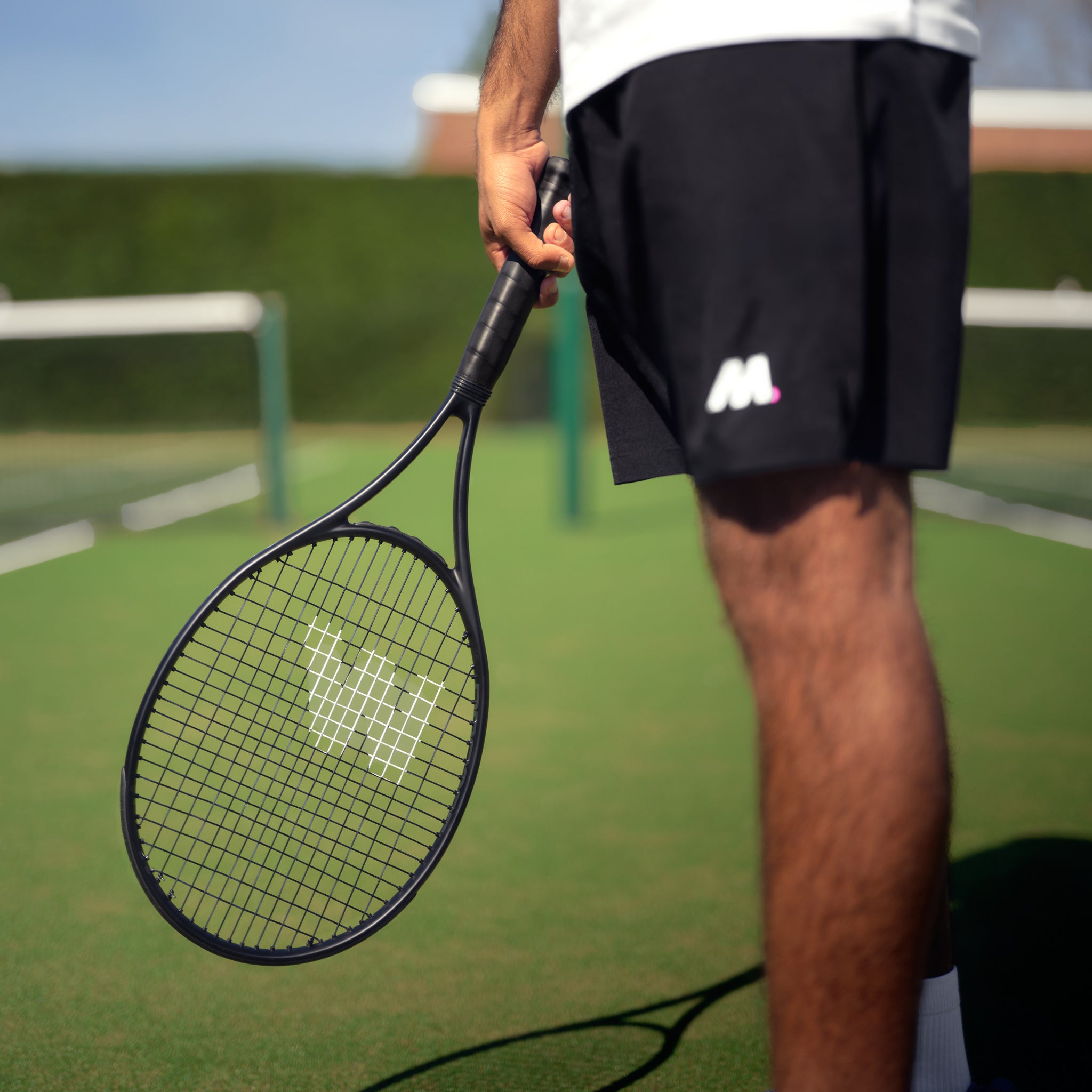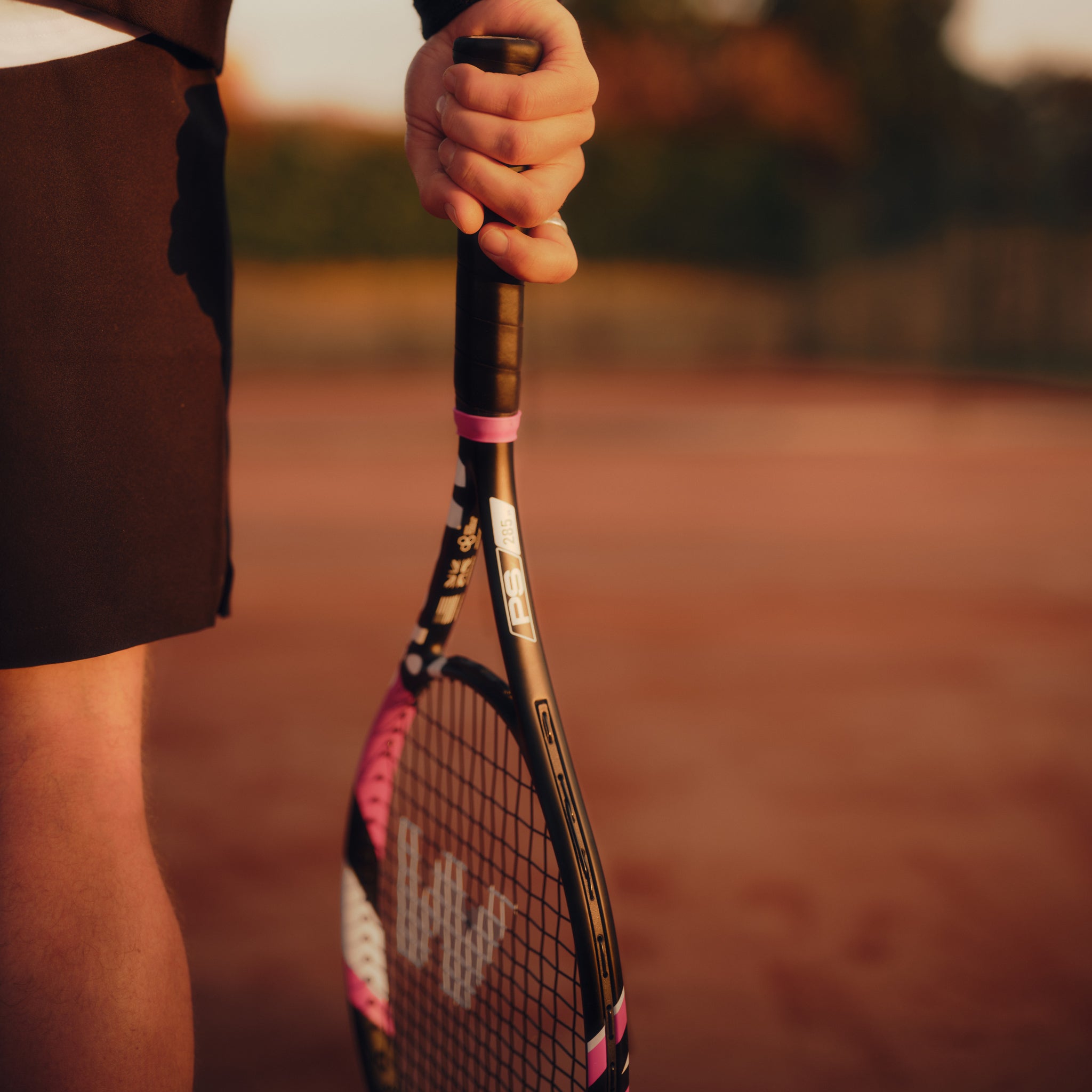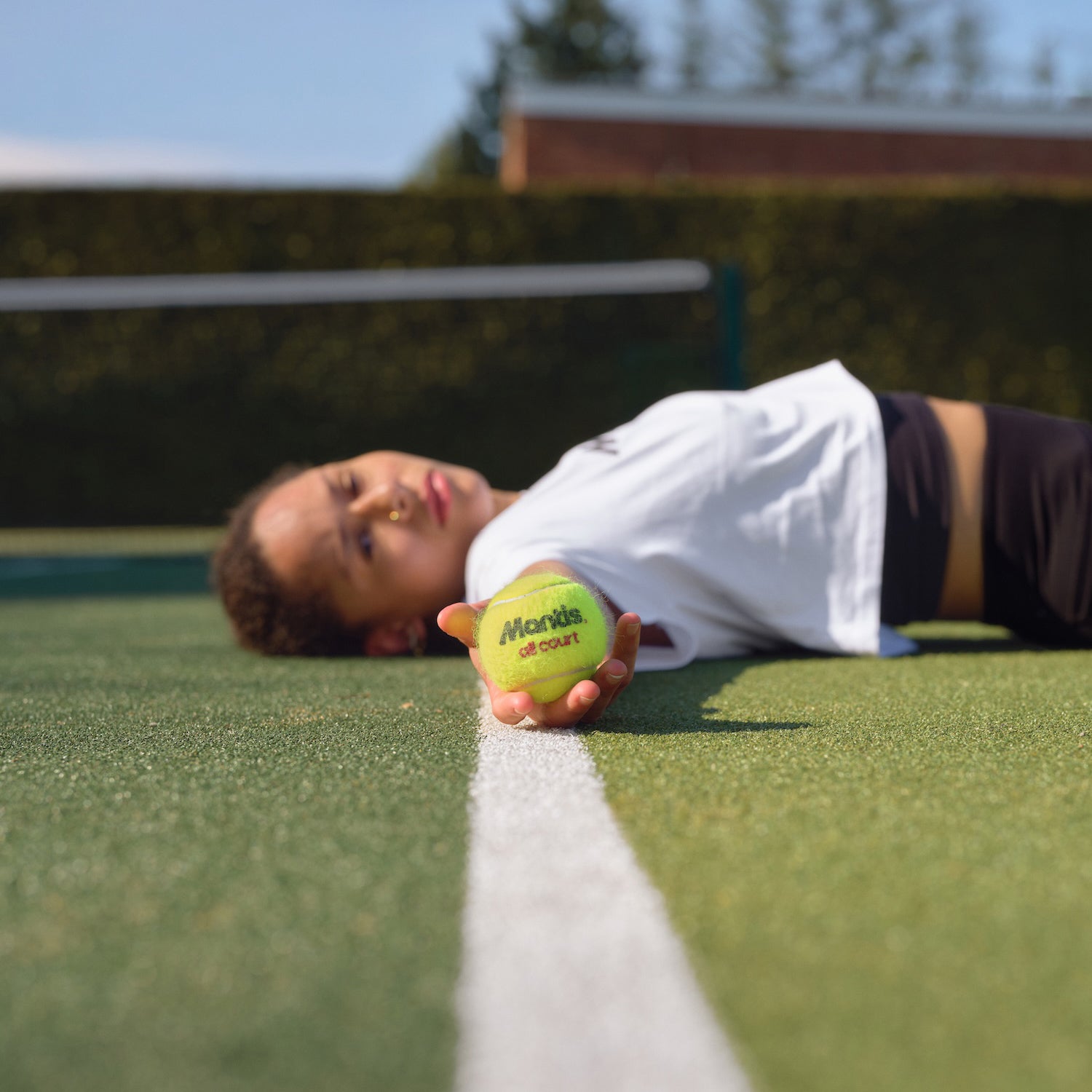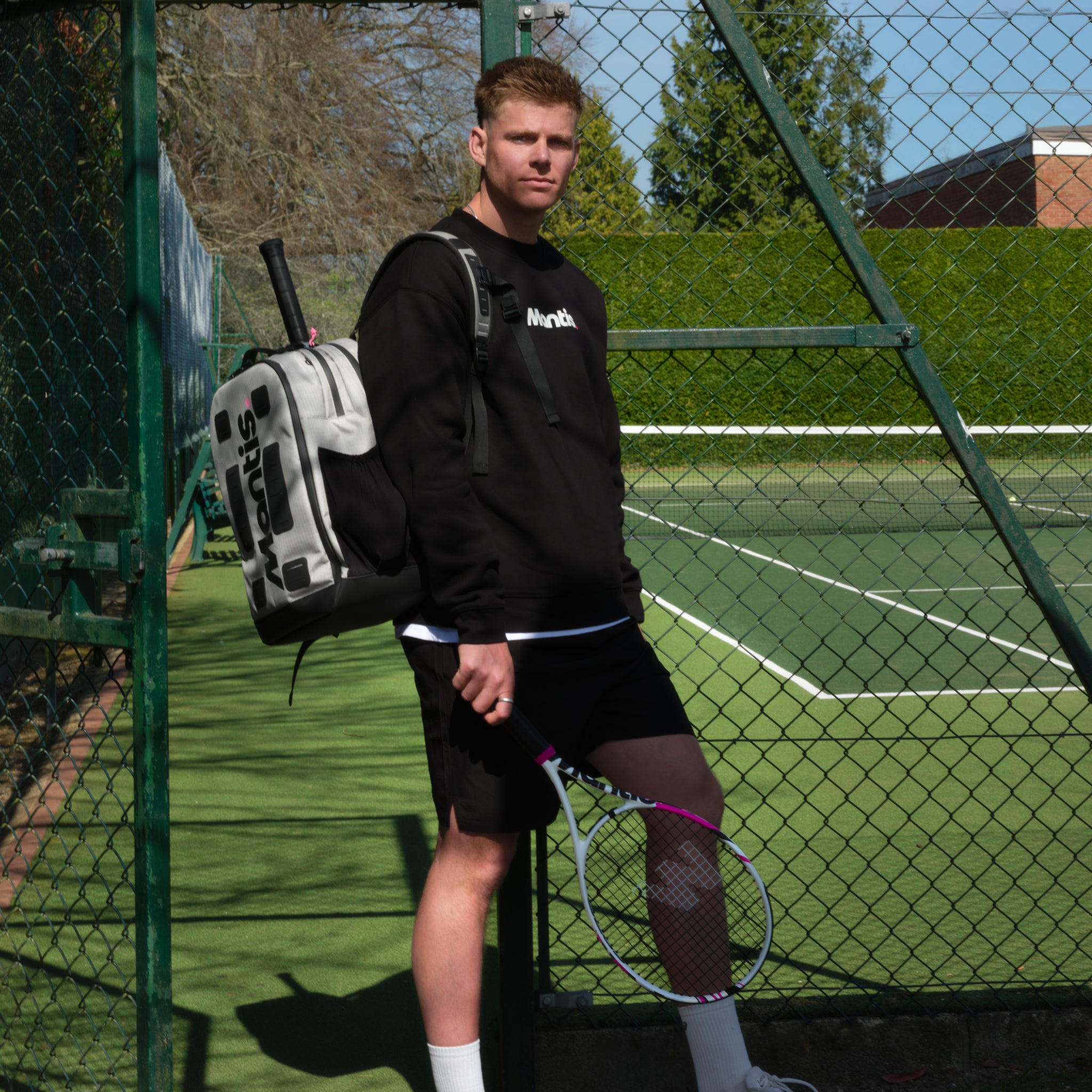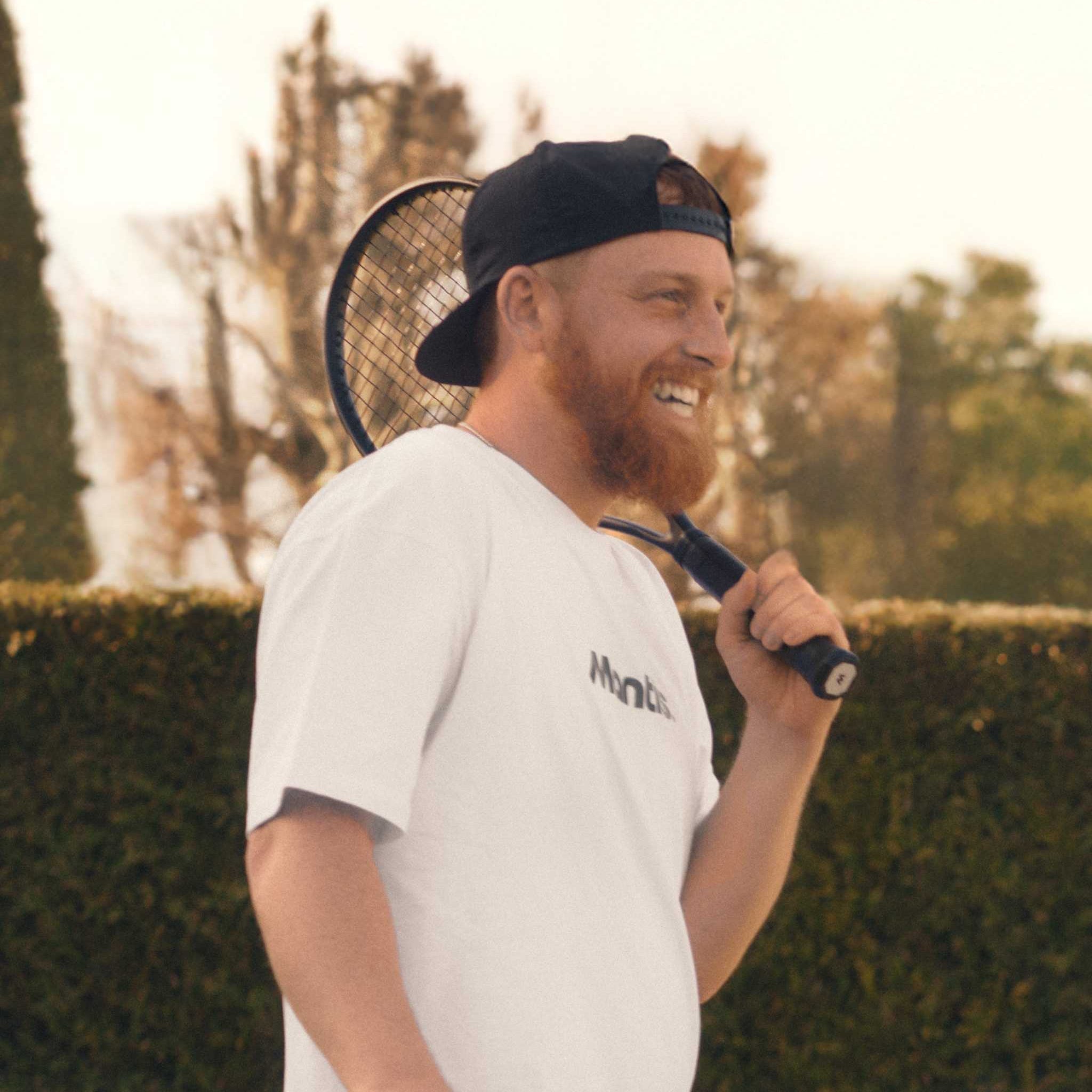
To really make your mark and coach tennis effectively, you need to be more than just a good player. It's a blend of deep technical know-how, sharp session planning, and a genuine understanding of how players develop over time. This means setting goals that make sense for your players, crafting engaging lessons that are more than just repetitive drills, and getting the right qualifications to build a credible career. For anyone looking to coach tennis in the UK, that journey starts with the LTA's certification system, a path we explore in our guide to tennis footwork drills.
Coach Tennis Effectively by Building Your Foundation
Stepping onto the court as a coach is about so much more than showing someone how to hit a perfect forehand. At Mantis, we've seen time and again that the best coaching is built on a solid foundation: a player-first mindset, thoughtful planning, and a real passion for helping others improve.
Your job is to create an environment where players of all ages and abilities feel motivated and can actually see the progress they're making, session after session. Of course, having the right tennis balls and equipment makes a massive difference in how effective that training can be.
A solid coaching foundation really begins with knowing who you're coaching. A junior picking up a racket for the first time needs a completely different approach than a competitive adult trying to find more consistency in their matches. The secret is to establish clear, achievable goals that are tailored to each person or group you work with.
Setting Clear Player Goals
Before you even think about feeding the first ball, you need to know what success looks like for your player. And it's not always about winning matches. More often, it’s about those small, incremental improvements that build skill and, just as importantly, confidence.
Here’s how you might break it down:
- For Beginners: The focus has to be on fun and fundamentals. Your goals might be as simple as making consistent contact with the ball, learning the basic grips, and just getting comfortable with the layout of the court.
- For Intermediate Players: Now you can get a bit more technical and tactical. Objectives could include improving their second serve percentage, developing a reliable backhand they can trust under pressure, or learning how to construct points.
- For Advanced Players: The goals here become highly specific, often targeting those tiny gains that make all the difference. Think about refining shot selection during a high-stakes point or mastering the transition from baseline to net.
Setting these goals gives your lesson plans real direction and shows your players a clear path forward. It’s how you turn a vague ambition like "I want to get better" into concrete, actionable steps.
Understanding the UK Coaching Pathway
If you're serious about coaching tennis professionally in the UK, there's a structured pathway designed to ensure quality and build your credibility. The Lawn Tennis Association (LTA) runs a multi-level qualification system that maps out a clear career progression.
It all starts with the Level 1 Coaching Assistant, which gets you on court helping a fully accredited coach. From there, you can move up to Level 2, which allows you to lead beginner groups on your own as part of a club programme.
Full professional status really kicks in at Level 3. This qualification gives you the green light to work with a wide range of players, both individually and in groups. The higher levels, like 4 and 5, are for coaches aiming for senior roles, such as running an entire club programme or working with elite, high-performance athletes. The LTA has been shaping British tennis since it was founded way back in 1888, and its coaching system reflects that long history.
Designing Lessons That Get Real Results
A great tennis lesson is more than just a list of drills; it’s a journey. We’ve found that the best sessions are carefully crafted experiences, designed to push players while keeping them hooked. Building a dynamic, progressive lesson plan is what keeps players engaged and, ultimately, what makes them book their next session.
Of course, even the best-laid plans fall flat without the right gear. That’s why something as basic as selecting the right tennis balls for training is a crucial first step.
The secret to a session that really clicks is its structure. A solid 60-minute lesson needs a clear beginning, middle, and end. This ensures players are warmed up properly, challenged technically, and still switched on mentally right to the final minute. A good framework stops the lesson from feeling disjointed and makes sure every moment on court has a purpose.
The Anatomy of a 60-Minute Session
We like to think of a lesson plan like a story. The warm-up sets the scene, the main drills are the core of the plot, and the cool-down wraps everything up nicely. This arc helps players get the most out of their time and solidifies what they’ve learned. Skip a part, and you risk poor performance or, even worse, an injury.
This simple infographic gives you a clear visual of how to balance the different parts of an effective 60-minute lesson.
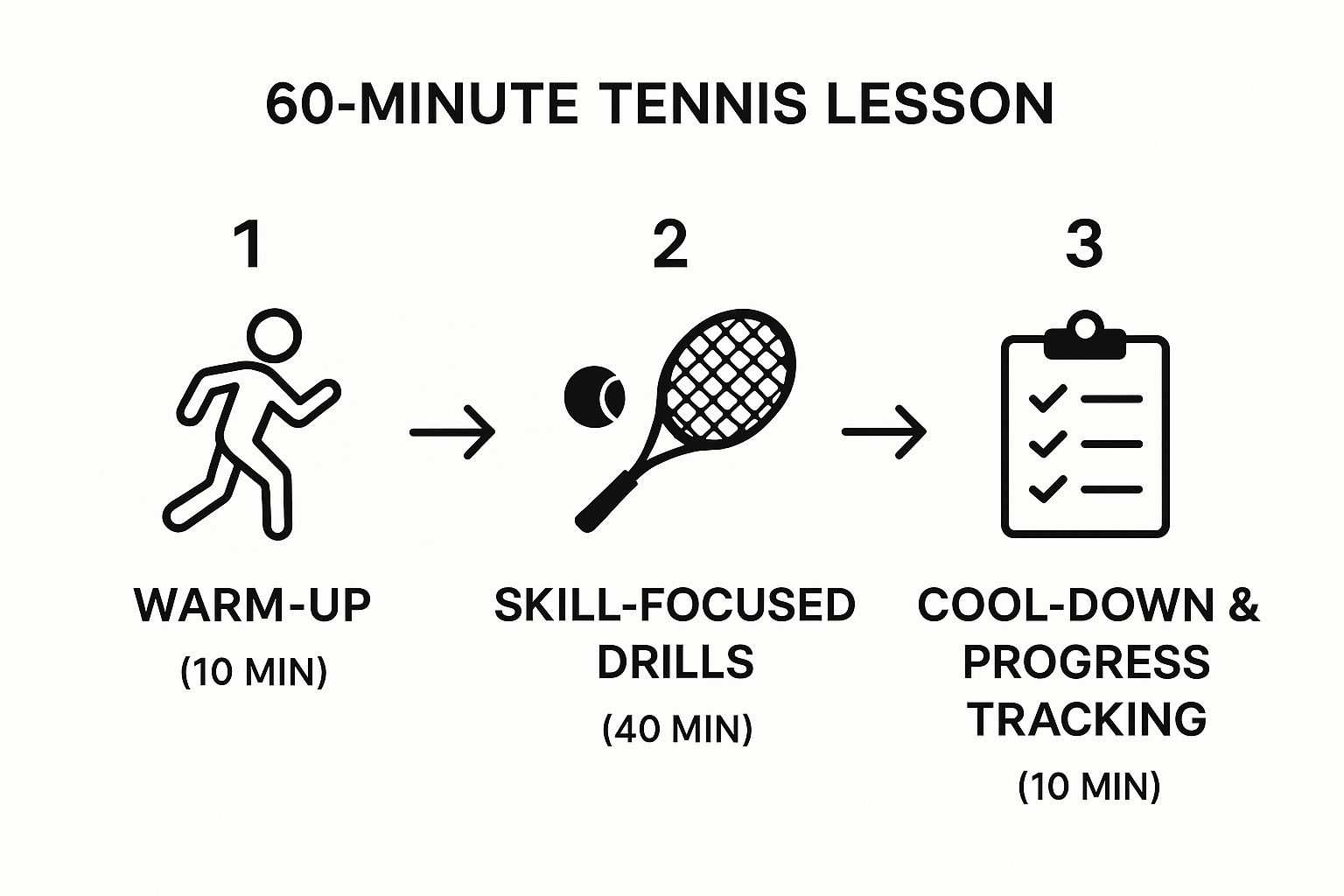
As you can see, the real engine room of the lesson is that middle block. Dedicating a solid 40 minutes to skill-focused work is where you’ll see the biggest improvements.
Here’s a practical breakdown of how you might structure that hour to keep the energy high and the learning focused.
Sample 60-Minute Lesson Plan Structure
| Phase | Duration (Minutes) | Objective & Example Activities |
|---|---|---|
| Warm-Up | 10 | Prepare the Body & Mind: Start with dynamic stretches (leg swings, arm circles), then move to mini-tennis rallies inside the service boxes to get a feel for the ball. |
| Skill Development | 20 | Introduce & Refine the Core Theme: Focus on technique with basket-fed drills. Example: Forehand cross-court depth. Feed balls and give specific technical feedback. |
| Application Drills | 20 | Put Skills into a Game Context: Move to cooperative or competitive drills. Example: 'Baseline Kings' game where players score points for hitting deep, consistent groundstrokes. |
| Cool-Down | 10 | Recap & Recover: Finish with point play focusing on the day's theme, followed by static stretching. Briefly recap one or two key takeaways for each player. |
This structure provides a reliable template, but the real magic happens when you bring it to life with a clear focus.
Theming and Progression
To stop lessons from becoming a random collection of activities, every session should have a theme. It gives the hour a clear purpose and helps players understand why they're doing a particular drill. A theme could be anything from ‘baseline consistency’ to ‘aggressive net play’.
Better yet, a theme-based approach lets you build skills logically over a series of weeks.
- Week 1 Theme: Baseline Consistency. The focus here is pure rallying. We'd work on footwork, maintaining good depth, and just getting comfortable hitting lots of balls. Drills might include simple cross-court rallies or a '2-on-1' where two players team up to move a single player around the baseline.
- Week 2 Theme: The Approach Shot. Building on last week's consistency, we now introduce the transition game. The goal is to teach players how to recognise a short ball and move forward with purpose, turning defence into attack.
- Week 3 Theme: Aggressive Net Play. Now that they’re comfortable coming forward, we focus on finishing the point. Drills would centre on approach-and-volley sequences, reaction volleys, and overheads.
This kind of logical layering is how players connect the dots. They start to see how individual shots fit together to build a complete game plan. It’s a core part of any smart coach tennis strategy.
A key part of successful coaching is adapting to the group in front of you. It's rare to have a group where every player is at the exact same skill level. The art is in modifying a single drill to challenge everyone appropriately.
For instance, if we’re working on volleys, you can have multiple things happening at once. Your beginners might be doing simple cooperative volleys from the service line. At the same time, on the same court, your more advanced players could be hitting specific targets with their volleys or playing the point out competitively.
For more fantastic coaching ideas and industry insights, the team over at Racket Business offers expert articles that are always worth a read.
Mastering the Essential Technical Drills
Great technique is the foundation of any solid tennis player, but building it takes more than just hitting a thousand balls. Our job as coaches is to create drills that not only groove reliable strokes but also get the player to understand why they're doing what they're doing. Here at Mantis, we've found the most effective drills are the ones that connect the mechanics of a swing to a real result on the court. It's about turning deliberate practice into pure instinct.
A deep well of drills means you can adapt to any player, whether they're just starting out or a seasoned competitor. The real skill is knowing which drill solves which problem—from a shaky ball toss to a leaky backhand slice. Of course, perfect strokes mean nothing if your player can't get to the ball. That's why smart movement is non-negotiable, and we strongly suggest pairing these exercises with what you'll find in our guide to essential tennis footwork drills.
Building Strokes with Basket-Fed Drills
Basket-fed drills are a coach’s best friend. They let you strip everything back and work on one specific part of a stroke without the pressure of a live rally. This is where you build the muscle memory for a solid swing path, a clean contact point, and a balanced recovery. Because you control the feed's pace, spin, and placement, it's the perfect laboratory for making technical tweaks.
Let's say a player's forehand swing is all over the place. A simple cross-court feed, right into their hitting zone, lets them focus purely on the swing. You can give immediate, direct feedback on their take-back or follow-through right in the moment.
- Forehand Grooving: Feed consistent waist-high balls to their forehand, getting them to hit cross-court into a target area. This is all about building consistency and control.
- Backhand Slice Work: To develop a good slice, you need to get low. Feed balls that are ankle-to-knee high, forcing the player to bend and execute that sharp, cutting motion.
- Sharpening Volleys: Stand at the net and fire quick, varied feeds to a player on the service line. This will really test their reflexes and their ability to control the racket face.
Developing Rally Tolerance with Live-Ball Exercises
Once the basic mechanics are looking better, it's time to throw them into a more dynamic situation. Live-ball drills bring in the unpredictability of a real point. Suddenly, your player has to deal with different spins, speeds, and depths coming from an actual opponent. These drills are less about pristine form and more about building what we call rally tolerance—the grit to hang in a point with consistency.
A classic for this is the "cross-court rally" game. Two players hit diagonally, trying to reach a set number of shots in a row, maybe 10 or 15 consecutive balls. It's a simple concept, but it's brilliant for building focus, rhythm, and the patience needed for long baseline battles.
Moving a player from the safety of basket-feeding to the chaos of a live rally is a huge developmental milestone. It closes the gap between practising a shot in a vacuum and actually using it when it counts.
Sharpening Accuracy with Target-Based Games
Nothing makes a drill more engaging than adding some targets. It instantly turns a monotonous exercise into a competitive game, making practice more fun while sharpening a player's accuracy and intent. Just by putting down a few cones or markers, you give players a clear visual goal. They start thinking about where the ball is going, not just getting it over the net.
A great one for this is the "Clear the Cones" game.
- First, set up three to five cones along the opposite baseline.
- The player’s mission is to knock them all down using either their forehand or backhand.
- To make it harder, you can add rules, like they have to alternate between hitting cross-court and down-the-line to get the targets.
The beauty of these games is how easily you can scale them. For beginners, the targets might be massive zones. For advanced players, you can shrink them down to tiny spots that demand real precision under pressure. This gamified approach is how you connect technical skill to tactical success, which is ultimately what coaching is all about.
Coaching Tactical Awareness for Match Play
Technically sound strokes are the foundation, but they're only half the battle. From our experience, the real art of coaching lies in turning a great ball-striker into a smart competitor—someone who knows how to build a point and, ultimately, win the match.
A picture-perfect forehand means very little if you don't have the court IQ to use it when the pressure's on. This is where we shift our focus from pure mechanics to strategic thinking. It’s less about what to hit and more about how and why you're hitting it. To really thrive in those tight moments, a player's head has to be in the right place, a topic we get into in our guide on sports psychology in tennis.
The way to bridge this gap is by introducing game-based scenarios and drills that force players to think. We need to move them away from mindless repetition and get them making decisions, reading their opponent, and adjusting their plan on the fly.
First-Strike Tennis Drills
One of the best ways to cultivate an attacking mindset is through ‘first-strike’ drills. These are all about owning the first two shots of the rally: the serve and the very next ball, the 'serve-plus-one'. The whole point is to get players immediately looking for an opportunity to take control, not just get the rally started.
A simple but incredibly effective drill we use is to have the server hit a specific serve—say, a slice out wide. We'll then feed a likely return, like a short cross-court ball. The server’s job is to pounce on it with the right attacking shot—their 'plus-one'—and hit a designated target. It’s a brilliant way to teach anticipation and how to dictate play from the get-go.
By zeroing in on the serve-plus-one, you train players to view the serve not just as a starting gun, but as the opening chess move. It’s a calculated play designed to force a weak reply and finish the point early.
Competitive King of the Court Games
To bring a bit of real-match intensity to a practice session, you can't beat competitive games. 'King of the Court' is one of our go-to drills because it gets players used to performing with something on the line—even if it's just staying on the court while a queue of challengers is waiting to knock them off.
Here’s a typical setup:
- One player—the 'King'—is on one side of the net.
- A line of challengers is ready on the opposite side.
- We'll feed a ball in to start the point.
- If the King wins, they stay put and take on the next challenger. If they lose, it’s straight to the back of the queue, and the winner becomes the new King.
This format is fantastic for teaching players how to handle those must-win points. You can also layer on tactical rules to focus on specific patterns, like "no drop shots" or "you must get to the net within three shots".
Drills for Opponent Analysis
A huge part of tactical tennis is spotting and exploiting what your opponent doesn't do well. We love designing drills where one player has to role-play a specific weakness—maybe they have a shaky backhand or they're slow moving out to their forehand.
Their partner’s job is simple: identify that weakness and attack it relentlessly to win the point. This sharpens their observational skills, teaching them to look for patterns and make calculated decisions instead of just hitting to the open court. By weaving these kinds of strategic drills into your sessions, you can help a player evolve from being just consistent to being a truly formidable competitor.
Running a Successful Tennis Coaching Business
There's more to being a great tennis coach than knowing your way around the court. To build a lasting career, you need a solid grasp of business fundamentals – from finding clients to marketing your services and keeping the books in order. Here at Mantis, we know that the off-court skills are just as vital as the on-court drills. The good news? With the right gear and a smart strategy, turning your passion for tennis into a thriving profession is well within your reach.
Let's talk numbers. In the UK, the economics of coaching can be quite promising. The average tennis coach earns around £28 per hour, which works out to a gross annual salary of about £34,400. That's a decent figure, sitting nearly £5,000 above the national average wage. Of course, coaches working at top-tier clubs or with elite players can earn significantly more, but those positions are highly sought after. Your LTA qualification level plays a huge role here; entry-level coaches often start out part-time, whereas those with Level 4 or 5 qualifications are in a much better position to land senior, higher-paying roles. For a deeper dive into coaching salaries, allabouttennis.co.uk is a great resource.
Building Your Roster of Players
Your reputation is everything in this game. Building a loyal client base comes down to being reliable, communicating clearly, and, most importantly, delivering results. While word-of-mouth is pure gold, you can't just sit back and wait for it. You have to be proactive.
Here are a few proven ways to attract new players:
- Run Taster Sessions: A free or heavily discounted introductory lesson is a brilliant way to let people experience your coaching style first-hand. It's your chance to turn a curious newcomer into a committed regular.
- Launch Group Programmes: Think about creating targeted clinics like 'Adult Beginners' or 'Junior Improvers'. These not only foster a great sense of community but also provide a reliable and consistent income stream.
- Connect with Local Clubs: Get your name out there at local tennis clubs, schools, and community centres. Becoming the recognised, go-to coach in your area will open up more doors than you can imagine.
One of the biggest pitfalls for new coaches is waiting for players to find them. You have to be visible, approachable, and professional at all times. Your on-court expertise might get them interested, but it’s your off-court business sense that will keep them coming back for more.
Marketing and Keeping Things Organised
In this day and age, a solid online presence isn't just a nice-to-have; it's essential. This doesn't mean you need a complicated, expensive website. Simple, consistent social media activity can work wonders. Share clips of your lessons, celebrate your players' successes, or post quick-fire tips. It all helps to raise your profile. For any coach serious about expansion, developing a strong social media marketing strategy is a key piece of the puzzle.
Beyond getting the word out, smooth administration is what will save you from burnout. Use simple, modern tools to manage your schedule, handle payments, and keep in touch with your clients. The more organised you are behind the scenes, the more energy you'll have to focus on what truly matters: being on the court and helping your players improve their game.
Common Questions Every Tennis Coach Asks
Stepping into the world of tennis coaching, or even just looking to sharpen your existing skills, always brings up questions. We get it. At Mantis, we believe that sharing what we've learned is one of the best ways to lift the sport for everyone. That’s why access to solid resources, like our deep dive into sports psychology in tennis, is so crucial for any coach’s growth.
Here are a few of the most common questions we hear from coaches, whether they're just starting out or have been on the court for years.
What's the First Step to Becoming a Coach in the UK?
For anyone serious about coaching in the UK, the starting line is the LTA Level 1 Coaching Assistant qualification. Think of it as your foundation.
This course gets you up to speed on the essentials: court safety, clear communication, and how to organise simple drills. It’s the official first rung on the ladder, and you’ll need it to assist a head coach and begin your journey toward higher qualifications and eventually running your own sessions.
How Do I Keep Kids Engaged in a Lesson?
This is a big one. With junior players, fun is non-negotiable. If they're not having fun, they're not learning.
Forget long, repetitive drills. Keep things short, dynamic, and game-based. Use colourful cones and mini-nets, and turn drills into imaginative challenges. We've found it's far better to build fundamental motor skills like balance and coordination through enjoyable activities, rather than getting bogged down in perfect technique too early.
Team games are another fantastic tool. They not only keep energy levels high but also build a great social atmosphere on the court. For more great ideas and industry insights, the folks over at Racket Business are an excellent resource for coaching professionals.
It's easy to get lost in the technical side of tennis, but remember this: the best coaches are brilliant communicators and motivators. Patience, adaptability, and the knack for explaining complex movements in simple terms are what separate good coaches from great ones. Building a real rapport with your players and creating a positive, encouraging space is where the magic really happens.
At Mantis, our focus is on creating the high-performance rackets, balls, and gear that give coaches and players the edge they need. See our full range of expertly crafted equipment at https://mantissport.com.
